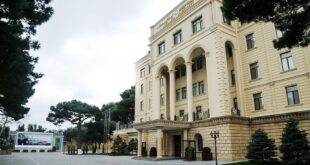The occupied areas of Nagorny Karabakh represented a large agricultural region within Azerbaijan. Suitable intermountain and foothill plains, plateaus and the occupied parts of the Minor Caucasus create the favorable conditions for development of plant-growing and cattle-breading fields. Grain-growing, fodder production, vine-growing, tobacco-growing, potato-growing, cotton-growing, dairy farming and meat farming, particularly sheep-breeding dominated in the agriculture.
Attention to vine-growing field of the Nagorny Karabakh, developed since ancient times, increased in 1970s. Large specialized sovkhoz-plants with modern techniques was established in connection with development of vine-growing and wine-growing. One of the new commodities in the region was tobacco- growing.
Numbers of agriculture enterprises, including kolkhozes, sovkhozes, agriculture unions and agro firms, operating in the occupied territories, stopped their activity in result of Armenian aggression (table 7).
Thus, 311 agriculture enterprises, 145 new established vine and wine sovkhozes, equipped with up-to- date technique and particularly Aghdam horse sovkhoz, bred well known Karabakh pedigree horses, 135 kolkhozes and 31 inter-economy enterprises were ruined in the occupied territories. 1365 trailer transports, 3425 different sowing and trailer tractors, grain and cotton combiners etc., presented material-technical base of agriculture and not available for farmer by their current prices remained in the occupied territories.
The agriculture enterprises and technique of the occupied territories (the data of 1988).
| Occupied regions | Agriculture enterprises | Including | Transport | Tractors | ||
| Sovkhozes | Kolkhozes | Inter-economic enterprises | ||||
| The NKAR | 99 | 43 | 49 | 7 | 800 | 2254 |
| Lachin | 30 | 28 | – | 2 | 60 | 70 |
| Kalbadjar | 37 | 4 | 30 | 3 | 28 | 32 |
| Aghdam | 34 | 1 | 10 | 6 | 257 | 392 |
| Fuzuli | 44 | 25 | 15 | 4 | 94 | 265 |
| Jabrayil | 24 | 7 | 14 | 3 | 77 | 145 |
| Gubadli | 25 | 10 | 12 | 3 | – | 109 |
| Zangilan | 18 | 10 | 5 | 3 | 49 | 158 |
| Total | 311 | 145 | 135 | 31 | 1365 | 3425 |
7296 hydraulic units, 36 pumping stations, 26 irrigation systems, 18 head plants of irrigation system, inter-economic irrigation channels of 1200 km, 5600 km intra-economic systems were destroyed, 127,7 thousand hectares fertile lands remained. Thousands of peoples were deprived of life source – land in the Caucasus region with insufficient lands.
Internal displaced persons, deprived of aforesaid agriculture technique, met with difficulties in the new regions, where they settled. They should rent agriculture techniques by high prices or use manual labor. All these complicated the daily life of refugees and internal displaced persons.
611,3 thousand internal displaced persons, exiled from occupied regions of the Nagorny Karabakh, are deprived of agricultural products, cultivated on the native lands. The plain territories, where IMPs settled, own other climate and agricultural products, cultivated appropriate to it. It is very difficult to grow such agricultural products in the new territories. Villager, bred cattle in the mountain territory of Kalbadjar, faced with great difficulties in cotton-growing of the Barda region, where they settled. Table 9 shows production of plant-growing and cattle-breeding in the occupied regions.
Eventually, 14,3% of grain, 31,5% of vine, 14,5% of meat, 17,1% of milk, 19,3 of wool and 17% of cocoon, produced in the Azerbaijan Republic, fell to the share of the occupied regions. Ecologically pure and qualitative products were produced in these regions.
The data on production of agriculture products in the occupied Nagorny Karabakh Autonomous Republic and adjacent regions of Azerbaijan (1988)
| Occupied regions | Plant products | Cattle-breeding products | |||||||
| Grain (1000
ton) |
Cotton (1000 ton) |
Vine (1000
ton) |
Potato (1000 ton) |
Meat (1000
ton) |
Milk (1000
ton) |
Egg (1000
ton) |
Wool (ton) |
Cocoon (ton) |
|
| The NKAR | 100,0 | – | 71,8 | 2765 | 10,2 | 36,5 | 11,1 | 477 | 89,0 |
| Lachin | 3,0 | – | – | 46,0 | 2,0 | 4,1 | – | 198 | – |
| Kalbadjar | 1,0 | – | – | – | 1,0 | 3,1 | – | 86 | – |
| Aghdam | 30,1 | 19,0 | 1,2 | 5,0 | 2,7 | 12,6 | 2,3 | 297 | 379 |
| Fuzuli | 31,9 | 1,5 | 100,1 | – | 1,5 | 6,8 | 1,1 | 128 | – |
| Jabrayil | 20,1 | – | 42,0 | 13,0 | 1,4 | 6,6 | – | 130 | 282 |
| Gubadli | 6,7 | – | 2,9 | 55,0 | 0,6 | 3,3 | – | – | 14,4 |
| Zangilan | 4,6 | – | 16,3 | 64,0 | 0, | 2,5 | – | 20 | 82,0 |
| Total: | 179,4 | 20,5 | 324,3 | 2348 | 20,0 | 75,5 | 14,5 | 1360 | 846,4 |
| Az. Repin % | 14,3 | 3,3 | 31,5 | 6,3 | 14,5 | 17,1 | 3,6 | 19,3 | 17,0 |
Armenian aggression caused more damage to the highly developed cattle-breeding fields of these regions. As Azerbaijan SSR directed great deal of means to the mountainous regions, decreased taxes, developed individual farms in order to catch up the backlog in these territories. All these measures leaded to development of cattle-breeding fields in the occupied mountainous regions.
Unexpected and consecutive occupation of Azerbaijan regions did not allow leading livestock out of war zone beforehand. Small groups of leaded out livestock died of starvation and thirsty on the way.
Number of the cattle in the regions occupied in 1988
| Occupied regions | Cattle | Including cows and buffalos | Sheep and goats | Pigs |
| The NKAR | 90227 | 29524 | 225791 | 81434 |
| Lachin | 42057 | 15284 | 242775 | – |
| Kalbadjar | 33298 | 11736 | 107760 | – |
| Agdam | 45127 | 16351 | 194300 | 1210 |
| Fuzuli | 36820 | 13578 | 144370 | – |
| Jabrayil | 26489 | 9536 | 118885 | – |
| Gubadli | 21026 | 8392 | 30098 | – |
| Zangilan | 18085 | 6843 | 34902 | – |
| Total | 313129 | 111244 | 1098881 | – |
| Az. Rep. Specific weight in % | 15,8 | 14,9 | 19,2 | 38,7 |
Eventually, 311 agriculture enterprises, including 145 new vine-wine plants, 1365 automobiles, 3425 sowing and trailer tractors, 7296 hydraulic units, 62 water pumps and irrigation aggregates, 1200 inter- economic droves, 645,5 thousand hectares land fit for agriculture, 185,5 thousand hectares plough lands, 40 thousand hectares new vine plantations, beard fruit, were destroyed, annually on average 79,4 thousand ton grain, 20,5 thousand ton cotton, 324,3 thousand vine, 23,5 thousand ton potato and other plant products, 313,1 thousand heads of cattle, including 111,2 thousand heads of cow and buffalo, 1 million 98 thousand heads of sheep and goat, as well as 20 thousand ton meat, 75,5 thousand ton milk, 846 ton cattle-breeding products were lost in result of occupation of Azerbaijan territories since 1989.
 Oval Useful news from Azerbaijan and Caucasus
Oval Useful news from Azerbaijan and Caucasus


